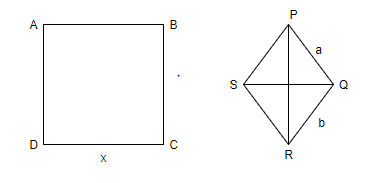
List the differences between a square and a rhombus.
Answer
582.6k+ views
Hint: Draw a square and a rhombus. Compare their different properties such as length of sides, the measure of angles, area and perimeter, length of diagonals to find the differences between them.
Complete step-by-step answer:
We have to list the differences between a square and a rhombus.
We will firstly draw a square and a rhombus and then compare their various properties.

Here, ABCD is a square and PQRS is a rhombus.
We observe that a square is a parallelogram whose all sides are of equal length. While rhombus is a parallelogram whose opposite sides are of equal length.
All the four angles of a square are equal ${{90}^{\circ }}$. However, in a rhombus, the opposite angles are of equal measure. Thus, all the sides of a square are perpendicular to each other. However, the sides of a rhombus are not perpendicular to each other.
Both the diagonals of a square are of equal length. However, the length of diagonals of a rhombus is unequal.
The area of a square with a side of length ‘x’ is given by ${{x}^{2}}$. However, the area of a rhombus is half of the product of the length of the diagonals.
The perimeter of a square with a side of length ‘x’ is given by 4x. However, the perimeter of a rhombus whose sides are of length ‘a’ and ‘b’ is given by $2\left( a+b \right)$.
Hence, we have listed all the differences between a square and a rhombus.
Note: It’s necessary to draw both the figures to observe the differences between them. Otherwise, we might miss out on some differences, or we should memorize all the properties of both square and rhombus.
Complete step-by-step answer:
We have to list the differences between a square and a rhombus.
We will firstly draw a square and a rhombus and then compare their various properties.

Here, ABCD is a square and PQRS is a rhombus.
We observe that a square is a parallelogram whose all sides are of equal length. While rhombus is a parallelogram whose opposite sides are of equal length.
All the four angles of a square are equal ${{90}^{\circ }}$. However, in a rhombus, the opposite angles are of equal measure. Thus, all the sides of a square are perpendicular to each other. However, the sides of a rhombus are not perpendicular to each other.
Both the diagonals of a square are of equal length. However, the length of diagonals of a rhombus is unequal.
The area of a square with a side of length ‘x’ is given by ${{x}^{2}}$. However, the area of a rhombus is half of the product of the length of the diagonals.
The perimeter of a square with a side of length ‘x’ is given by 4x. However, the perimeter of a rhombus whose sides are of length ‘a’ and ‘b’ is given by $2\left( a+b \right)$.
Hence, we have listed all the differences between a square and a rhombus.
Note: It’s necessary to draw both the figures to observe the differences between them. Otherwise, we might miss out on some differences, or we should memorize all the properties of both square and rhombus.
Recently Updated Pages
How do you convert r6sec theta into Cartesian form class 10 maths CBSE

How do you solve dfrac5y3dfracy+72y6+1 and find any class 10 maths CBSE

If sin A+B1 and cos AB1 0circ le left A+B rightle 90circ class 10 maths CBSE

On the number line 10 is to the of zero class 10 maths CBSE

How do you solve 5xge 30 class 10 maths CBSE

In the following sentence supply a verb in agreement class 10 english CBSE

Trending doubts
Write an application to the principal requesting five class 10 english CBSE

Why is there a time difference of about 5 hours between class 10 social science CBSE

Write a letter to the principal requesting him to grant class 10 english CBSE

The Equation xxx + 2 is Satisfied when x is Equal to Class 10 Maths

What is the median of the first 10 natural numbers class 10 maths CBSE

Write examples of herbivores carnivores and omnivo class 10 biology CBSE




